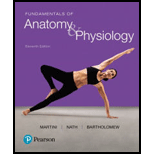
Pearson eText Fundamentals of Anatomy & Physiology -- Instant Access (Pearson+)
11th Edition
ISBN: 9780136874089
Author: Frederic Martini, Judi Nath
Publisher: PEARSON+
expand_more
expand_more
format_list_bulleted
Concept explainers
Question
Chapter 26, Problem 1CP
Summary Introduction
To determine:
The major functions of the urinary system.
Introduction:
The most of the
Expert Solution & Answer
Explanation of Solution
The urinary system includes the production, storing and elimination of urine. The major functions of the urinary system are as follow:
- Excretion: The removal of metabolic waste products from body fluids.
- Elimination: When the waste out from the body is discharged.
- Homeostatic regulation: Regulating blood volume, blood pressure, regulation of plasma concentration of sodium, potassium, chloride and other ions, stabilizing pH of blood and so on.
Want to see more full solutions like this?
Subscribe now to access step-by-step solutions to millions of textbook problems written by subject matter experts!
Students have asked these similar questions
Give only the mode of inheritance consistent with all three pedigrees and only two reasons that support this, nothing more, (it shouldn't take too long)
O
Describe the principle of homeostasis.
Chapter 26 Solutions
Pearson eText Fundamentals of Anatomy & Physiology -- Instant Access (Pearson+)
Ch. 26 - Prob. 1CPCh. 26 - Prob. 2CPCh. 26 - Prob. 3CPCh. 26 - Prob. 4CPCh. 26 - Damage to which part of a nephron would interfere...Ch. 26 - Prob. 6CPCh. 26 - Prob. 7CPCh. 26 - List the factors that influence net filtration...Ch. 26 - Prob. 9CPCh. 26 - Prob. 10CP
Ch. 26 - Prob. 11CPCh. 26 - Prob. 12CPCh. 26 - Prob. 13CPCh. 26 - Prob. 14CPCh. 26 - Prob. 15CPCh. 26 - What effect would a high-protein diet have on the...Ch. 26 - Prob. 17CPCh. 26 - Prob. 18CPCh. 26 - Prob. 19CPCh. 26 - Define nephrolithiasis.Ch. 26 - Prob. 21CPCh. 26 - Prob. 22CPCh. 26 - Prob. 23CPCh. 26 - Prob. 1RQCh. 26 - The basic functional unit of the kidney is the (a)...Ch. 26 - The process of urine formation involves all of the...Ch. 26 - Prob. 4RQCh. 26 - The distal convoluted tubule is an important site...Ch. 26 - Prob. 6RQCh. 26 - Prob. 7RQCh. 26 - Prob. 8RQCh. 26 - Trace the pathway of the protein-free filtrate...Ch. 26 - Prob. 10RQCh. 26 - Prob. 11RQCh. 26 - Prob. 12RQCh. 26 - Prob. 13RQCh. 26 - What are the primary effects of angiotensin II on...Ch. 26 - Prob. 15RQCh. 26 - When the renal threshold for a substance exceeds...Ch. 26 - Prob. 17RQCh. 26 - Prob. 18RQCh. 26 - When ADH levels rise, (a) the amount of water...Ch. 26 - The control of blood pH by the kidneys during...Ch. 26 - Prob. 21RQCh. 26 - Prob. 22RQCh. 26 - Prob. 23RQCh. 26 - Prob. 24RQCh. 26 - Prob. 25RQCh. 26 - Prob. 26RQCh. 26 - In response to excess water in the body, (a)...Ch. 26 - Prob. 28RQCh. 26 - Prob. 29RQCh. 26 - What effect would drinking a solution of mannitol...Ch. 26 - The drug Diamox is sometimes used to treat...Ch. 26 - Prob. 1CCCh. 26 - What will likely happen to the glomerular...
Knowledge Booster
Learn more about
Need a deep-dive on the concept behind this application? Look no further. Learn more about this topic, biology and related others by exploring similar questions and additional content below.Similar questions
- Explain how the hormones of the glands listed below travel around the body to target organs and tissues : Pituitary gland Hypothalamus Thyroid Parathyroid Adrenal Pineal Pancreas(islets of langerhans) Gonads (testes and ovaries) Placentaarrow_forwardWhat are the functions of the hormones produced in the glands listed below: Pituitary gland Hypothalamus Thyroid Parathyroid Adrenal Pineal Pancreas(islets of langerhans) Gonads (testes and ovaries) Placentaarrow_forwardDescribe the hormones produced in the glands listed below: Pituitary gland Hypothalamus Thyroid Parathyroid Adrenal Pineal Pancreas(islets of langerhans) Gonads (testes and ovaries) Placentaarrow_forward
- Please help me calculate drug dosage from the following information: Patient weight: 35 pounds, so 15.9 kilograms (got this by dividing 35 pounds by 2.2 kilograms) Drug dose: 0.05mg/kg Drug concentration: 2mg/mLarrow_forwardA 25-year-old woman presents to the emergency department with a 2-day history of fever, chills, severe headache, and confusion. She recently returned from a trip to sub-Saharan Africa, where she did not take malaria prophylaxis. On examination, she is febrile (39.8°C/103.6°F) and hypotensive. Laboratory studies reveal hemoglobin of 8.0 g/dL, platelet count of 50,000/μL, and evidence of hemoglobinuria. A peripheral blood smear shows ring forms and banana-shaped gametocytes. Which of the following Plasmodium species is most likely responsible for her severe symptoms? A. Plasmodium vivax B. Plasmodium ovale C. Plasmodium malariae D. Plasmodium falciparumarrow_forwardStandard Concentration (caffeine) mg/L Absorbance Reading 10 0.322 20 0.697 40 1.535 60 2.520 80 3.100arrow_forward
- please draw in the answers, thank youarrow_forwarda. On this first grid, assume that the DNA and RNA templates are read left to right. DNA DNA mRNA codon tRNA anticodon polypeptide _strand strand C с A T G A U G C A TRP b. Now do this AGAIN assuming that the DNA and RNA templates are read right to left. DNA DNA strand strand C mRNA codon tRNA anticodon polypeptide 0 A T G A U G с A TRParrow_forwardplease answer all question below with the following answer choice, thank you!arrow_forward
arrow_back_ios
SEE MORE QUESTIONS
arrow_forward_ios
Recommended textbooks for you
 Human Physiology: From Cells to Systems (MindTap ...BiologyISBN:9781285866932Author:Lauralee SherwoodPublisher:Cengage Learning
Human Physiology: From Cells to Systems (MindTap ...BiologyISBN:9781285866932Author:Lauralee SherwoodPublisher:Cengage Learning


Human Physiology: From Cells to Systems (MindTap ...
Biology
ISBN:9781285866932
Author:Lauralee Sherwood
Publisher:Cengage Learning




12 Organ Systems | Roles & functions | Easy science lesson; Author: Learn Easy Science;https://www.youtube.com/watch?v=cQIU0yJ8RBg;License: Standard youtube license